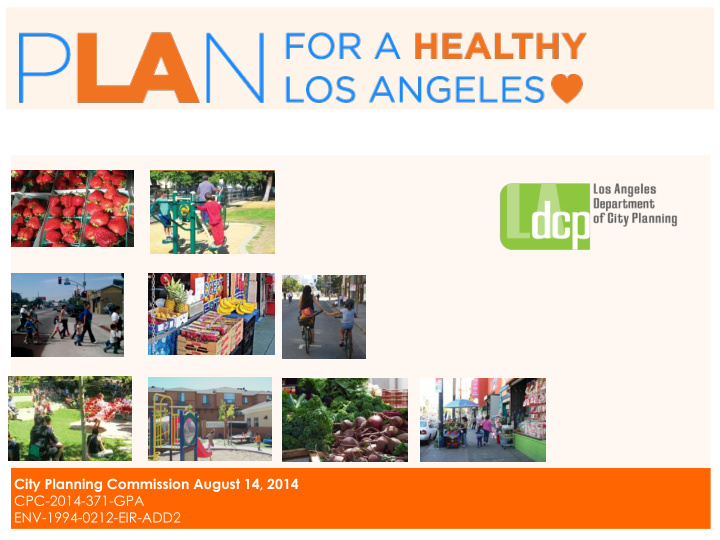



City Planning Commission August 14, 2014 CPC-2014-371-GPA ENV-1994-0212-EIR-ADD2
What is the Plan intended to do? Improve health and wellness Reduce disparities and poor health outcomes Improve collaboration Increased access to resources Reduce negative impacts Promote economic and social prosperity Continue to engage Angelenos
Early Development Published Health Atlas Established and convened Community Advisory Committee Established and convened Technical Advisory Committee Community engagement Established and convened Expert Panel Released draft Health and Wellness Element (Plan for a Healthy Los Angeles) 90-day public comment period
Health Atlas: An Examination of Health Conditions in the City of Los Angeles
Hardship Index Indicators: Overcrowding Poverty Employment Status Education Age Income Southeast LA has the greatest level of hardship
Life Expectancy at Birth Range 72.8 years (Watts) 84.7 years (Bel-Air Brentwood- Pacific Palisades) Watts has lowest life expectancy in the State
Childhood Obesity Prevalence of Childhood Obesity in Brentwood was 11% Prevalence of Childhood Obesity at 30% or greater: Boyle Heights Harbor Gateway South Los Angeles Southeast Los Angeles
Motor Collisions with Pedestrians & Cyclists Between 2001-2010 Highest number in Southeast LA Pedestrians and cyclists represented over 50% of the City’s traffic fatalities in 2010
Over 20 zip codes in the City of Los Angeles are within the • state’s 10 percent most polluted communities Residents in Westlake and Southeast Los Angeles have less • than half an acre of park space available per 1,000 residents, significantly lower than the City average of 8.9 acres Average annual homicide rates in some higher income • neighborhoods were nearly zero, compare to more than 20 homicides per 100,000 residents in Southeast Los Angeles and West Adams-Baldwin Hills-Leimert Over 60% of residents in areas around South Los Angeles are • cost-burdened by housing, paying more than 30% of their income on housing costs .
Health Atlas helped identify key policy areas including: • Healthy food access • Education and work opportunities • Air quality and GHG emission • Park and open space access • Crime prevention • Active transportation • Displacement Plan addressed poor health outcomes citywide and also in low- income communities where there are disproportionate higher rates of poor health outcomes.
Community Outreach
90-Day Public Comments Equity Districts and zones Nutrition Accountability Displacement Oil extraction and Access to health Community diversity fracking promoting goods and Equitable parks Omissions services Economic opportunities Community Aging in place Food engagement Community Funding Use limitations beautification Gun control Smoke-free housing Comprehensive public Incompatible land use Underutilized space safety Mental Health Glossary of terms
Incorporating feedback Revised existing policies Created new policies Development new objectives Updated the narrative Revised programs Added new implementation programs Created a new Goal with corresponding objectives and Policies Transferred comments to DCP specific staff
Plan structure Introduction Chapters 1-7, each represent a Goal Each goal includes a series of Objectives List of Policies (Policy topic, policy, and narrative) Chapter 8, list of Implementation Programs Appendices
Goal 1: Los Angeles, a Leader in Health and Equity 1.1 Leadership 1.2 Collaboration 1.3 Prevention 1.4 Education 1.5 Plan for health 1.6 Poverty and health
Goal 2: A City Built for Health 2.1Access to goods and services 2.2 Healthy building design and construction 2.3 Access for individuals with disabilities 2.4 Aging in place 2.5 Schools as centers of health and well-being 2.6 Repurpose underutilized spaces for health 2.7 Access to health services 2.8 Basic amenities 2.9 Community beautification 2.10 Social connectedness through environmental design 2.11 Foundation for health
Goal 3: Bountiful Parks and Open Spaces 3.1 Park funding and allocation 3.2 Expand parks 3.3 Los Angeles River 3.4 Parks and recreation programs 3.5 Park safety 3.6 Local partnerships 3.7 Water recreation 3.8 Active spaces
Goal 4: Food that Nourishes the Body, Soul, and Environment 4.1 Land for urban agriculture and healthy food 4.2 Local food systems, connections, and industry 4.3 Farmers markets 4.4 Equitable access to healthy food outlets 4.5 Food security and assistance 4.6 Food cycle sustainability 4.7 Empower Angelenos to grow and eat healthy food 4.8 Food innovations
Goal 5: An Environment Where Life Thrives 5.1 Air pollution and respiratory health 5.2 People 5.3 Smoke-free environments 5.4 Noxious activities 5.5 Brownfield remediation 5.6 Resilience 5.7 Land use planning for public health and GHG emission reduction
Goal 6: Lifelong Opportunities for Learning and Prosperity 6.1 Early childhood education 6.2 Higher education 6.3 Lifelong learning 6.4 Arts, culture, and services that enhance well-being 6.5 Public libraries 6.6 Workforce training 6.7 Youth employment
Goal 7: Safe and Just Neighborhoods 7.1 Gang prevention programs 7.2 Safe passages 7.3 Innovative policing and public safety 7.4 Community policing 7.5 Reintegration of the formerly incarcerated 7.6 Diversion
Implementation Plan 88 implementation programs • Identifies time frame (immediate, short-term, mid-term), • focus areas, responsible departments, key partners Some are currently under way, while others are • dependent on securing future funding and resources
Next Steps Consideration by: Planning and Land Use Management Committee (March)
Facebook: https://www.facebook.com/healthplanLA Twitter: https://twitter.com/healthplanLA Project Website: healthyplan.la Project Team: Lauren Grabowski Claire Bowin 213.978.1212 213.978.1213 Lauren.Grabowski@lacity.org Claire.Bowin@lacity.org
Recommend
More recommend